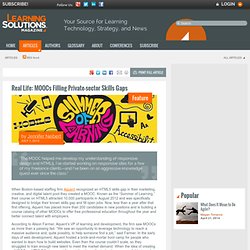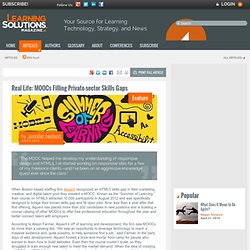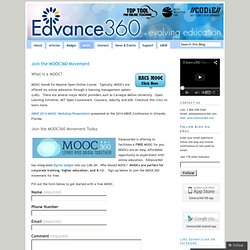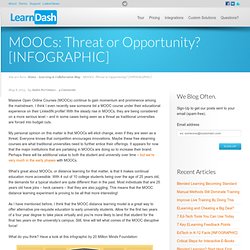

Why Big Data, Not MOOCs, Will Revolutionize Education. MOOCs in Higher Education: Options, Affordances, Pitfalls (Part 1) by Apostolos Koutropoulos. “Rewarding teaching and learning experiences can be had with MOOCs.

This is the major opportunity. However, the role of the instructor needs reconceiving, and it needs to build upon what we know from research in online education. MOOCs in Higher Education: Options, Affordances, and Pitfalls (Part 2) by Apostolos Koutropoulos. “Regardless of the MOOC you plan on offering, there are four rules of thumb that I would like to propose: Put learners first; do instructional design first; pick your faculty carefully; and don’t worry about the dropout rate!”

In part 1, I began expanding on the poster session I presented at NERCOMP2013 on massive open online course (MOOC) pedagogy, technologies, and the role of the instructor, along with some basic history, the two types of MOOCs that have evolved to date, and some observations about technology and pedagogy. In part two, I aim to expand a bit more on my poster: the role of assessment, credentialing, copyright, and some of my MOOC principles.
Apostolos Koutropoulos’ 2-part article on MOOCs in Higher Education Assessment and credentialing When thinking of courses we invariably think of how we will assess mastery, or at least gain some understanding of those who complete it. cMOOC practice Currently, cMOOCs generally don’t provide formal instructor assessment. xMOOC practice. MOOCs in Higher Education: Options, Affordances, Pitfalls (Part 1) by Apostolos Koutropoulos. “Rewarding teaching and learning experiences can be had with MOOCs.

This is the major opportunity. However, the role of the instructor needs reconceiving, and it needs to build upon what we know from research in online education. We shouldn’t be turning back the clock, because what works for a face-to-face audience does not necessarily work, as is, in an online environment, and in a massive environment it has the potential to fail massively.” Recently, I was discussing the current state of MOOCs (massive open online courses) and their broader applicability to academia with colleagues. MOOCs started in academia and spread like wildfire in 2012 when certain “elite” Universities started offering their courses for free on the web through their own means or through venture-capital funded startups like Coursera.
Real Life: MOOCs Filling Private-sector Skills Gaps by Jennifer Neibert. “The MOOC helped me develop my understanding of responsive design and HTML5.

I’ve started working on responsive sites for a few of my freelance clients—and I’ve been on an aggressive knowledge quest ever since the class.” When Boston-based staffing firm Aquent recognized an HTML5 skills gap in their marketing, creative, and digital talent pool they created a MOOC. Known as the “Summer of Learning,” their course on HTML5 attracted 10,000 participants in August 2012 and was specifically designed to bridge their known skills gap and fill open jobs.
Now, less than a year after that first offering, Aquent has placed more than 200 candidates in new positions and is building a course catalog of other MOOCs to offer free professional education throughout the year and better connect talent with employers. Real Life: MOOCs Filling Private-sector Skills Gaps by Jennifer Neibert. “The MOOC helped me develop my understanding of responsive design and HTML5.

I’ve started working on responsive sites for a few of my freelance clients—and I’ve been on an aggressive knowledge quest ever since the class.” When Boston-based staffing firm Aquent recognized an HTML5 skills gap in their marketing, creative, and digital talent pool they created a MOOC. Known as the “Summer of Learning,” their course on HTML5 attracted 10,000 participants in August 2012 and was specifically designed to bridge their known skills gap and fill open jobs. Now, less than a year after that first offering, Aquent has placed more than 200 candidates in new positions and is building a course catalog of other MOOCs to offer free professional education throughout the year and better connect talent with employers. MOOC Major Players. The MOOC landscape is taking shape, and just like social networking sites before it, the major players are starting to emerge.

It’s still too early to tell which one of these will fall the way of MySpace, but as Facebook has pointed out, there is often very little room at the top. Given the shifting environment, it isn’t always clear what options are out there. Below is a list of the more popular MOOC options available: 1. Udacity – This MOOC option has decided to work with individual professors rather than educational institutions. 2. 3. Join the MOOC Movement. What is a MOOC?

MOOC stands for Massive Open Online Course. Typically, MOOCs are offered via online education through a learning management system (LMS). 5 MOOC Building Platforms. Now that MOOCs are hitting the scene, everyone wants to jump on board!

Granted, some want to get into the game in the hopes of making a quick dollar (somehow?) , but others genuinely want to know how they can create their own MOOC for educational purposes. MOOC Latest Trends [INFOGRAPHIC. As we enter into the early phases of MOOCs, we are now starting to see some early trends, particularly as more institutions start to jump on board.

Speaking of which, it’s interesting to note that only 10% of schools do not plan to offer any type of online course – which means the groundwork is there for MOOCs to gain some traction in years to come. Interestingly though, 44% of schools don’t have any plans to offer MOOCs. I think this is because most are waiting on the sidelines to see how everything plays out.
Not a bad strategy, but in some cases they may be playing catch-up should the concept really begin to take off. For the time being, I can see how MOOCs will primarily be used as a supplement to formal education – a perspective supported by the fact that 67% of people believe that MOOCs will never replace the traditional, residential classroom (according to the Enterasys inforgraphic). Time will tell what MOOCs become. To Harness MOOCs, Focus on the Outcomes. MOOCs: Threat or Opportunity? [INFOGRAPHIC. Massive Open Online Courses (MOOCs) continue to gain momentum and prominence among the mainstream.

I think I even recently saw someone list a MOOC course under their educational experience on their LinkedIN profile! With the steady rise in MOOCs, they are being considered on a more serious level – and in some cases being seen as a threat as traditional universities are forced into budget cuts. My personal opinion on this matter is that MOOCs will elicit change, even if they are seen as a threat. Everyone knows that competition encourages innovations. Maybe these free elearning courses are what traditional universities need to further entice their offerings.
MOOCs. MOOCs. Accessible Online Courses: Techniques and Tips by Jenny Hill. “It is most important that learners can access the material, so understanding the learners and thinking about potential barriers is key. Making this your focus will change your thought processes and allow you to avoid potential accessibility issues from the start, saving time and improving the quality of your work.”
The Professors Behind the MOOC Hype - Technology. Dave Chidley for The Chronicle Paul Gries, of the U. of Toronto, has taught MOOCs on computer science. By Steve Kolowich What is it like to teach 10,000 or more students at once, and does it really work? The largest-ever survey of professors who have taught MOOCs, or massive open online courses, shows that the process is time-consuming, but, according to the instructors, often successful.
Nearly half of the professors felt their online courses were as rigorous academically as the versions they taught in the classroom. The survey, conducted by The Chronicle, attempted to reach every professor who has taught a MOOC. Five Ways Free Online Classes Will Change College, or Not. Free Online Courses. Advance your College Education & Career. Coursera's Business Model: Career Services. What's a "MOOC" and Can Maritime Training Benefit From It? If you are one of the (dwindling number of) e-learning skeptics, this article will give you heartburn. Ten Tips: Keep Learners Motivated in Your Open Online Cloud Course or MOOC (Part 6) by Inge de Waard.
“Don’t make a fuss about correct use of the English language—it is already difficult entering a course designed in another language. This also means that certain formulations might be awkward due to the misunderstanding of some English terms, which can lead to potential debates. Give every discussion thread or response the benefit of the doubt if at first it seems rude. It might just be a different cultural perception, or a different use of language.” Adding Learning Analytics to Your Open Online Cloud Course or MOOC (Part 5) by Inge de Waard. “The simplest learning analytics are those that count the hits and time spent on certain content pages.
So let’s take a look at how you can set this up using the free Google Analytics software, which is also available for mobiles.” Learning analytics are rapidly gaining interest and organizers are creating specialized conferences to dig deeper into the subject (e.g., learning analytics and knowledge). Learning analytics is an umbrella term for a variety of ways to analyze what happens in a course.
Choose and Embed Social Media in Your MOOC (Part 2) by Inge de Waard. “After signing up for the social media tools, all you need to do is to link them up to your course. Massive Open Online Courses: Setting Up (StartToMOOC, Part 1) by Inge de Waard. Build a Dashboard for your MOOC (Part 3) by Inge de Waard. “Netvibes makes it very easy to gather information on one topic from the Web—you only need to type in a keyword and Netvibes builds your dashboard automatically.”
Make Your Cloud/MOOC Course BYOD Friendly (Part 4) by Inge de Waard.